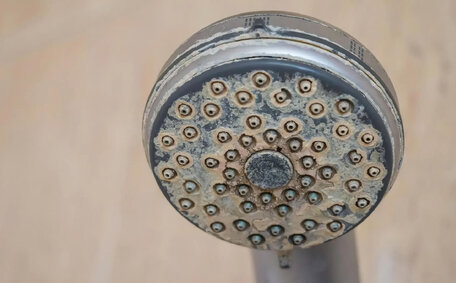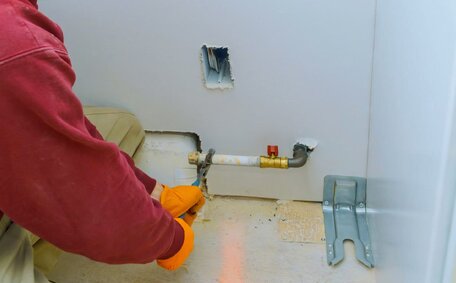Introducing Epoxy Resin Pipe Relining
Pipe restoration through relining is a popular alternative to full pipe replacement that utilises epoxy resin to rehabilitate damaged plumbing.
Epoxy resin is a strong, durable plastic material that can extend the lifespan of ageing pipes once applied as a protective lining. The process involves coating the inside of pipes with the resin to seal cracks and holes, restoring function without the need for major construction work.
Compared to traditional pipe replacement methods, relining offers numerous benefits. The process also causes minimal disruption to properties.
It is a trenchless technique that requires no digging, making it less invasive and faster than removing and replacing old pipes. Once set, the smooth epoxy lining prevents buildup and protects pipes from future corrosion or cracks.
Epoxy has become the resin of choice for modern relining projects thanks to its strength, ease of application, and chemical resistance. When correctly applied by experienced professionals, epoxy resin linings can restore pipes for decades to come.
What is Epoxy Resin?
Epoxy resin is a durable plastic material made from resin and hardener components. When mixed, these ingredients chemically react to create a tough, rigid plastic perfect for protecting pipes.
Once hardened, epoxy resin is waterproof and chemically resistant, meaning it won’t degrade inside pipes over time. It also adheres well to materials like metal and PVC. These characteristics make epoxy ideal for sealing and reinforcing existing plumbing as a pipe lining.
plumbing applications, epoxy resin is widely used in industrial flooring, auto body fillers, high-performance paints and protective coatings across aerospace, marine, electrical and transportation industries.
Importantly for safe use, epoxy resins made specifically for potable water pipes hold NSF/ANSI Standard 61 certification. This rigorously tests formulations to ensure they are safe for drinking water contact and won’t leach chemicals into the water supply when properly cured.
How Pipe Relining Works
Pipe relining is a multi-step process that renews drainage pipes without the need for full replacement.
First, technicians will use CCTV cameras to thoroughly inspect the pipe’s interior and identify any faults or damage. The pipe is then cleaned to remove debris and prepare the surface.
A woven fibre tube soaked with epoxy resin is fed through the pipe. Technicians control the tube’s size and positioning during the process. A woven fibre tube soaked with epoxy resin is fed through the pipe.
The resin saturates and coats the inner walls, sealing cracks and holes as it cures and hardens.
A final CCTV inspection checks for any defects before the relined pipe is ready for service. The whole process is trenchless and non-invasive, avoiding the need to dig up pipes, driveways or landscaping.
Compared to full pipe replacement, relining with epoxy resin is often faster, less damaging and more cost-effective. Given the resin’s durability, it also negates the need for frequent repairs down the track.
Expected Lifespan of Epoxy Resin Pipe Relining
When properly applied by trained professionals, epoxy resin linings offer exceptional longevity for restored pipes. Industry standards estimate epoxy pipe relining to have a service life between 30 to 50 years under typical conditions.
With continual advancements in epoxy technology and application techniques, it’s believed linings may even last up to 100 years. Rigorously tested ‘100-year epoxy’ products are paving the way for ultra-durable repairs. However lifespan depends on factors like pipe material, environment and maintenance.
Compare this to traditional pipe replacement using PVC or clay piping, which often needs replacing again after 15-25 years. Epoxy resin relining therefore provides double or even quadruple the lifespan through a less invasive process.
By essentially creating a ‘pipe within a pipe’, quality epoxy liners shield against corrosion and abrasion. This greatly delays deterioration, reducing the need for recurring repairs over time. Periodic inspections help detect any unlikely faults early.
With superior longevity compared to traditional methods, epoxy relining is a smart, future-proof investment in your plumbing infrastructure.
Typical Service Life
When installed correctly, epoxy resin linings generally last 30-50 years inside pipes. However, service life can vary greatly depending on environmental factors, pipe materials and usage patterns.
Pipes subjected to consistent flow volumes, moderate temperatures and non-corrosive drain water tend to see epoxies last towards the higher end of the 30-50 year range. Whereas fluctuating flow, temperature extremes or exposure to chemicals can accelerate wear.
Cast iron pipes usually allow longer lasting repairs than PVC, copper and galvanised steel alternatives, thanks to epoxy’s excellent adhesion to the metallic surface. Concrete and clay pipes also see good bonding results.
High velocity flows in industrial or commercial sites leads to faster degradation than lower, domestic flows. But periodic CCTV inspections help detect lining damage early before failure occurs.
With regular maintenance and favourable conditions, expert contractors claim 50+ year lifespans are achievable. Some ‘100 year epoxy’ products even pledge extreme durability. Although real-world longevity varies, quality epoxy relining undoubtedly lasts decades longer than traditional pipe materials.
Factors Affecting Durability
Several key factors impact the durability and lifespan of epoxy resin used in pipe relining projects.
Consistent Flow Rates - Epoxy linings last longer when subjected to steady, moderate water flows. High velocity flows cause faster wear and tear.
Water Composition - Exposure to corrosive substances, high mineral concentrations or extreme pH levels can degrade epoxies over time.
Temperature - Large temperature variances weaken epoxy, with high heat particularly damaging. Ideal conditions are 15-25°C.
UV Exposure - Sunlight and UV rays will cause epoxy to become brittle and fail prematurely if relined pipes are exposed aboveground.
Pipe Material - Superior bonding to metallic pipes allows longer lifespans than concrete, clay or plastic pipes.
Ground Movements - Shifting earth causing pipes to warp or stretch reduces lining integrity and accelerates failure.
Regular inspections help detect damage early before problems arise. But despite variables impacting durability, quality epoxy relining still offers vast improvements over traditional pipe lifespan estimates.
Maintenance for Longevity
Proper maintenance is key to maximising your pipe’s epoxy resin lining’s durability and lifespan.
Conducting annual CCTV pipe inspections lets technicians closely monitor the lining for wear or damage. Any identified faults can then be repaired early before catastrophic failure occurs. Pipe cleaning may also be recommended to keep the lining clear of abrasive debris and deposits over time.
Maintaining adequate heat and UV protection is also important for longevity. Ensuring relined pipes avoid direct sunlight exposure or extreme temperature fluctuations helps preserve structural integrity. Insulated box covers around aboveground pipes prevents weathering.
It’s also critical to promptly address any plumbing issues, leakage or evidence of tree root invasion discovered during maintenance checks. Identifying and rectifying potential threats keeps relined systems running optimally.
Adhering to the resin manufacturer’s care guidelines is advised too. This may involve avoiding exposure to certain chemicals or controlling water attributes that accelerate degradation.
While epoxy relining itself requires no ongoing upkeep, proactive maintenance and responsible usage meaningfully extends the lifespan of repairs. With periodic inspections and attentive preventative care, 50+ year service lives are readily achievable.
Cleaning Best Practices
When cleaning epoxy-lined pipes, use only gentle, non-abrasive agents to preserve the resin lining and maximise its lifespan.
Stay away from highly caustic or acidic cleaners which may degrade epoxy over time. Instead, mild detergents and water solutions are recommended.
Likewise avoid using highly abrasive materials that could scratch the smooth pipe surface. Steel wool, scouring pads and hard bristle brushes should not be used.
When clearing clogged drains or cutting tree roots, take care not to damage the structural integrity or sealing effectiveness of the epoxy barrier.
Always follow the resin manufacturer’s care instructions regarding chemical exposures too. Verify any cleaning agents are compatible.
With routine gentle cleaning and by avoiding harsh chemicals or scraping tools, epoxy linings can maintain their as-new condition for exceptionally long periods.
Waxing for Protection
Applying a protective wax coating onto cured epoxy resin linings is highly recommended to maintain their appearance and shine.
Over time, factors like UV exposure, abrasive flows and general wear and tear can dull and degrade the glossy resin surface. Quality wax products provide a sacrificial barrier against these elements.
Technicians should first ensure the epoxy lining has fully hardened and adhered correctly to the pipe interior before waxing. A thin, even application of wax is then worked over the surface using a clean soft cloth.
As the wax wears over months or years of use, periodic reapplication will be necessary. But keeping the lining wax-protected ensures the pipe system maintains its as-new sheen while enjoying maximum longevity.
Wax coatings are affordable, easy to apply protection for preserving cosmetic appeal. Combined with general maintenance to uphold structural integrity, waxing delivers full safeguarding of epoxy’s function and form.
When to Consider Replacement
While quality epoxy resin relining often lasts upwards of 50 years, there are certain signs indicating a full pipe replacement is required.
Extensive damage visible on CCTV inspection may exceed relining capabilities if severe corrosion, fractures or deformation have occurred. Where pipes have deteriorated beyond repair, replacement is the only option.
Persistent blockages, leaks and drainage issues after relining could also signal failures within the lining itself. If faults reappear despite professional repairs, the lining may need replacing.
Likewise, any detected faults that risk contamination or bacteria entering drinking supplies necessitate pipe replacement as the safest option. Epoxy issues should not compromise safe water delivery.
Discolouration, unusual smells or noticeable taste changes in water may also indicate epoxy lining failure and a need for complete pipe replacement.
For maximum safety and reliability, technicians will advise if full system replacement is the best solution over attempting further repairs in severely damaged drains.
Comparing to Pipe Replacement
When evaluating longevity between pipe relining and full drainage replacement, epoxy resin linings are the clear winner.
Industry estimates peg how long does the average lifespan of quality epoxy repairs last at 30-50+ years. Some advanced formulations even pledge up to 100 years durability. Compare this to traditional pipe replacement lifespans:
- PVC piping - 15-20 years
- Concrete piping - 20 years
- Clay piping - 25 years
- Steel piping - 30 years
Epoxy resin relining therefore doubles, triples or even quadruples the functional lifespan of drainage systems vs installing new pipes. The process also saves greatly on upfront costs. Pipe relining provides enduring structural renewal for 60-70% less than full replacement.
The trenchless application of epoxy resin beats the major excavation work, property damage and landscaping losses inevitable with traditional pipe replacements. The non-invasive relining method keeps existing pipes serviceable for decades longer.
For superior longevity, value and convenience, epoxy resin pipe relining outlasts and outperforms traditional piping solutions across the board.
An Eco-Friendly Solution
Beyond longevity advantages, epoxy resin pipe relining offers significant environmental benefits over traditional replacement methods.
As trenches don’t need excavating when rehabilitating pipes with epoxy, the reliance on heavy machinery and disruptive demolition is avoided. The localised process emits far less carbon than large-scale dig-ups, and sends substantially less waste material to landfill.
Epoxy’s unrivalled resistance to corrosion and extreme temperatures also boosts eco-credentials. Linings prevent rust accumulation and repeated part replacements - saving resources long-term. The seamless barrier won’t leach chemicals into soil or waterways either, preventing pollution.
By extending the service life of existing pipe assets up to 50-100 years, the need for new piping manufacture is also reduced. Compared to the 15-30 year average lifespan of new PVC, concrete and metal pipes, epoxy relining provides a dramatic conservation effect.
Ultimately, undergoing non-invasive epoxy resin renewal in place of traditional pipe replacements leaves a smaller ecological footprint. The trenchless method lessens environmental impact across manufacture, application and entire product lifecycle - a sustainable infrastructure solution.






